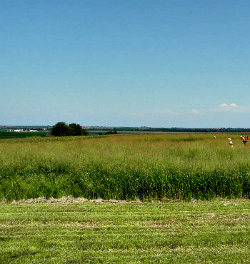Researchers delve into the economic incentives that would induce farmers to grow switchgrass for cellulosic biofuel.
Sponsoring Partner

Funded by AFRI. Learn More.
Table of Contents
- Abstract
- Research Purpose
- Research Activities
- What We Have Learned
- Why Is This Important?
- For More Information
- Contributors to This Summary
Abstract
A survey of crop farmers in the North-Central region of the United States finds that they would ask for an average of $230 per acre, or about $82 per dry ton, to grow switchgrass for cellulosic biofuel on their marginal crop land. The survey also found that farmers are more willing to use that land to produce switchgrass themselves, rather than lease out the land to another entity for growing switchgrass.
Research Purpose

The U.S. Congress has mandated, under the Renewable Fuel Standard, that cellulosic biofuels provide 16 billion gallons a year of transportation fuel by the year 2022. However, a sustainable biofuel industry requires a steady supply of cellulosic biomass, and in order to establish that supply, farmers must have an economic incentive to grow the feedstock.
For the last decade, researchers have been trying to determine how much cellulosic feedstock U.S. producers are willing and able to supply. Richard Perrin, Mustapha Alhassan, and Lilyan E. Fulginiti of the Department of Agricultural Economics at the University of Nebraska, Lincoln (UNL), wanted to refine and add to that research. They sought to find out how much revenue farmers in the North-Central region, the most productive grain-producing region in the country, would need in order to shift their marginal crop land into switchgrass production.
Switchgrass is an attractive feedstock crop for cellulosic ethanol because it produces large amounts of biomass, is native to the region and familiar to farmers, and can be grown across much of the United States.
Research Activities
Perrin and his colleagues used one of four standard approaches, called the contingent valuation approach, to gather information directly from farmers on potential choices. During the winter of 2014-2015, the researchers sent surveys to 2,100 farmers in 10 North-Central states and received responses from 54 percent.
Their research area was divided into three economic regions, defined by opportunity costs; they used Conservation Reserve Program rental rates to determine suggested prices for each region. (The Conservation Reserve Program, administered by the Natural Resources Conservation Service, pays farmers to grow grass rather than crops on marginal cropland.)
Their survey asked producers two whether, if they were offered a specific net return per acre, they would be willing to accept a contract to grow switchgrass on their least-productive field for the next five years. They were also asked if they would be willing to lease out that land for switchgrass production. The farmers were given information on the average cost of establishing, growing, and harvesting switchgrass, as well as average annual net revenue.
Each producer was randomly assigned one of nine different net return levels, providing information about potential production response at different price levels. The researchers then analyzed the results.
Their work was supported by the USDA National Institute of Food and Agriculture and by UNL’s Agricultural Research Division.
What We Have Learned
The average farm-gate net returns that farmers said they would accept—$230 per acre, or $82 per dry ton—is close to the goal of $84 per dry ton, delivered to the biorefinery, set by the U.S. Department of Energy (DOE), which leads the country’s renewable energy efforts. Regional land values and rental rates had a strong influence on the prices that farmers were willing to accept to convert to switchgrass. In the two sub-regions with lower land values and rental rates, average net returns of $75 and $82 per dry ton were acceptable. In the third region, however, where land values were highest, the acceptable $99-per-dry-ton price was much higher than the DOE’s goal.
Interestingly, farmers were more willing to grow their own switchgrass than lease out their land for that purpose. Farmers would only accept an average of $14 per acre more to lease their land (about $3.50 per ton), rather than to grow switchgrass themselves.
But in the biofuel system, that extra cost to biorefineries could be offset by savings in transaction costs and the scale of production. Biorefineries face significant transaction costs in trying to negotiate individual production contracts with the hundred or more producers required to supply the plant. The refieneries could instead offer to lease land at a blanket rate, producing and delivering the switchgrass from the individual farms themselves. While biorefineries would need to pay a higher rate to the farmer for the leasing approach, they could likely produce at lower cost because of scale economies, and reduce the transaction costs related to negotiating with farmers.
The research also found that the more pasture a farmer grew, the less likely he or she was to opt for switchgrass production, perhaps because switchgrass was viewed as a competitor to current grass and pasture activities. Likewise, the more grain a farmer grew, the more likely he or she was to favor switchgrass, perhaps because the two crops are complementary.
Why Is This Important?
Although the development of a cellulosic biofuel industry is lagging, it may someday thrive—but only if there is a consistent supply of affordable feedstocks, such as switchgrass. This study investigates more deeply the economic incentives that could persuade farmers to produce switchgrass for biomass. It also gives biofuel processors more information on how to obtain feedstocks, through negotiation with producers or leasing land to grow their own supply.
For More Information
- Perrin, Richard K, Lilyan Fulginiti and Mustapha Alhassan. 2017. Biomass from Marginal Cropland: Willingness of North Central US Farmers to Produce Switchgrass on Marginal Fields. Biofuels, Bioproducts and Biorefining (1/27/2017).
- Perrin, Richard, Lilyan Fulginiti and Mustapha Alhassan. 2016. Prospects for Switchgrass as an Energy Crop, Cornhusker Economics, University of Nebraska-Lincoln.
- Perrin, Richard, Kenneth Vogel, Marty Schmer and Rob Mitchell. 2008. Farm-Scale Production Cost of Switchgrass for Biomass. BioEnergy Research 1(1):91-97, March, 2008.
- Perrin, Richard K. 2014. Switchgrass Economics in the North Central Region of the U.S.A. Webinar.
- Perrin, Richard K. and Susan J. Harlow. 2014. The Economics of Switchgrass for Biofuel. extension.org.
- CenUSA Project Resources – information on the opportunities and challenges in developing a sustainable system for the thermochemical production of biofuels from perennial grasses grown on land marginal for row crop production.
Contributors to This Summary
Authors:
-
Richard Perrin, Jim Roberts Professor, Department of Agricultural Economics, University of Nebraska, Lincoln
-
Susan J. Harlow, Freelance Journalist
Peer Reviewer:
- F. John Hay, Extension Educator, University of Nebraska-Lincoln Extension
CenUSA Bioenergy is a coordinated research and education effort investigating the creation of a regional system in the Central US for producing advanced transportation fuels from perennial grasses on land that is either unsuitable or marginal for row crop production.* In addition to producing advanced biofuels, the proposed system will improve the sustainability of existing cropping systems by reducing agricultural runoff of nutrients in soil and increasing carbon sequestration.
CenUSA is supported by Agriculture and Food Research Initiative Competitive Grant no. 2011-68005-30411 from the USDA National Institute of Food and Agriculture.

